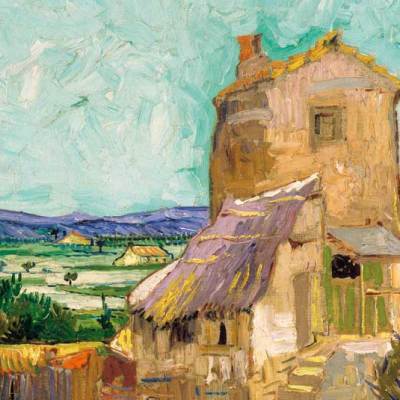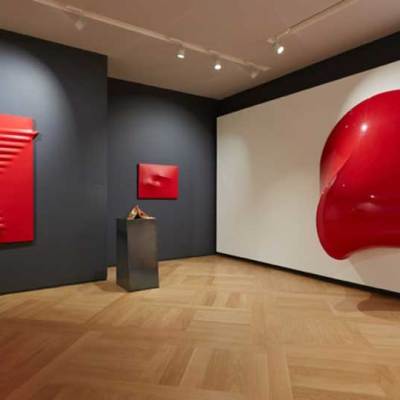From the February issue of Apollo: preview and subscribe here
Hiroshi Sugimoto is best-known for his large-format photographs of dioramas, seascapes and buildings, but he is also a collector and was once an antiquities dealer. He talks to Apollo about the links between his collection and his art, and about capturing the passing of time.
On a cold January afternoon, Hiroshi Sugimoto is in his New York studio, where he and his assistants have recently packed off to London a wide assortment of his own personal collection of fossils, antiques, first-edition books, and various relics of lost worlds for an upcoming exhibition of artists’ collections at the Barbican Centre.
Outside, the air is freezing – but inside, on one of the higher floors overlooking 24th Street, heat pipes through the studio, plentiful but inefficient, and the glow of the fluorescent lights against the concrete floors gives the impression of an office filled with people slowly wrapping up their day.
In an art world where there is a lot of chatter about galleries and studios opening further and further east – in Chinatown, the Lower East Side, and across the river into Brooklyn’s Bushwick and Greenpoint – Sugimoto’s Chelsea studio is something of an anachronism. Here, the mega galleries dominate these large stretches of city blocks – Gagosian is just down the street; David Zwirner, Hauser & Wirth, and Pace are not far off, too. The current Chelsea landscape sometimes feels more like a marketplace than a home to creativity, where tourists take art selfies in front of reflective Murakami sculptures, and bright, young painters fetch extravagant sums. But there is a longevity to Sugimoto’s presence that makes him impervious to these small motions of change.
Sugimoto was born in Tokyo, in 1948, and now splits his time between there and New York. His main preoccupation as an artist is with time, and how best to capture its meaning. His tool is the camera, and he self-deprecatingly likes to say that he applied to study photography because it was the easiest discipline to be accepted in at the Art Center College of Design in Pasadena, California, where he received his BFA in Fine Arts. But given the last century’s long debate about the value and place of photography in fine art, Sugimoto’s body of work is proof that the medium belongs firmly alongside sculpture and painting. If a photograph is a record of what we see, then Sugimoto is obsessed with how we see. One of his earliest and most impressive series is the ongoing Dioramas series, which he began in the mid 1970s, in which he photographed prehistoric scenes of life on display at the American Museum of Natural History.
Birds of South Georgia (2012), Hiroshi Sugimoto Photograph courtesy the artist © Hiroshi Sugimoto, courtesy Pace Gallery

Related review: ‘Hiroshi Sugimoto: Still Life’ at Pace Gallery, London
Sugimoto is a master of the long exposure and the large-format camera; the scenes are static and preserved, but in the true black and white tones of his gelatin silver prints, they are not entirely lifeless, either. Sugimoto’s ability to trick the eye – even in just an instant – juxtaposed with his open acknowledgement of the scene’s artificiality, demonstrates both his playful curiosity and also his rigorous technique. ‘The stuffed animals positioned before painted backdrops looked utterly fake,’ Sugimoto has said before of the Dioramas photographs. ‘Yet by taking a quick peek with one eye closed, all perspective vanished, and suddenly they looked very real. I’d found a way to see the world as a camera does. However fake the subject, once photographed, it’s as good as real.’
Sugimoto moved to New York City in 1974 after finishing his studies in California. There was a time when, like many young and struggling artists, his work did not yet support him financially and he remembers, after driving across the country in a VW van with his friends, marvelling at the economy of contemporary art – an industry then dominated by powerhouse-dealers such as Leo Castelli and Ileana Sonnabend. He tried his luck at a variety of jobs – he disliked working as an assistant to a commercial photographer – but eventually he and his wife opened a successful antiques shop on West Broadway in SoHo in 1979. ‘My wife was also a painter. We were married,’ Sugimoto says. ‘But it was difficult to live as two artists together, so we decided to divorce. For the first time, I asked my father to borrow some money to open the shop – but I didn’t tell him we were going to divorce and I needed money.’ Their gallery initially specialised in Japanese folk art, but grew to include a rare collection of Eastern antiquities, and the income it generated kept Sugimoto and his estranged wife afloat. When Sugimoto’s career took off, the need to run the shop became less urgent, but his interest in collecting remained. ‘Suddenly, my art started selling; I didn’t have to buy things for my clients, so I stopped it,’ Sugimoto says. ‘But,’ he adds with a sly smile, ‘I kept buying for myself.’
We are now facing each other at the centre desk in his studio’s main office, both of us seated in tan, swivelling Siège Tournant chairs. The Empire State Building can be seen from the one large, northern-facing window. Sugimoto’s table tops are covered in the mess of a man caught in the middle of working – with various books splayed open next to stacks of paper. He has brought to the table an 18th-century French book of anatomical illustrations, which he has placed to my left. A slender case of Second World War German-made glass eyes sits to my right, alongside an army doctor’s optical surgery kit and an antique set of eye lenses. These are some of the objects in the studio that haven’t yet been flown to London.
Sugimoto speaks both English and Japanese but is, unsurprisingly, most comfortable expressing himself visually. As he walks me through a list of what’s been packed off and what still remains here, he makes a point of showing me precisely what the value of each object is to him. He flips to an illustration of a woman’s rib cage in the French anatomy book. ‘This looks like a beautiful lady being opened while she is alive,’ he says, pointing to her face, which, it’s true, is expressive and aware despite the fact that her back is spliced open to reveal the bones and tissues. ‘On the contrary,’ Sugimoto says, ‘in British 18th-century anatomy books, the body’s expressions are completely dead. But this is almost like an angel – an angel being opened.’
There are no rules when it comes to hunting for antiques. Sugimoto says he could find something he loves at a flea market, at Sotheby’s, on the street. ‘It doesn’t matter how much I paid for it,’ he insists. Like many collectors, the price is immaterial to his desire to possess it – an impulse that can be as whimsical as it is deeply and inexplicably emotional. I am reminded of a short story by V.S. Pritchett called ‘The Camberwell Beauty,’ involving the obsessional nature of antique dealers: ‘…there is one object he broods on from one year to the next, most of his life; the thing a man would commit murder to get his hands on if he had the nerve, but I have never heard of a dealer who had; theft perhaps…’
Sugimoto’s collection includes stone-age tools, meteorites, Roman amulets, the remains of an Egyptian cat, and perhaps most astonishing, fossils that are anywhere from 20 to 30 million years old. If you think about it, Sugimoto says to me, a fossil is just like a photograph. ‘One side is negative, one side is positive. Same thing.’ Sugimoto is much more Zen about his practice of collecting than he is about his art. But obsession goes some way to explain his owning, for example, early editions of Isaac Newton’s Optics and the Principia Mathematica. ‘I can study them,’ Sugimoto explains to me patiently. ‘I just want to stay with them and I want to live with them. Some collectors want to buy [something] at auction and put it in storage and put it back to auction after a few years – as if it’s just investment. I’m interested in how the human eye captures images and reads the images and makes meaning out of them,’ he says. ‘So, in general, I just want to know what is going on in our world. And how a human being is aware of the outside of themselves. As a photographer, that’s what I was interested in in the first place: the perception of human existence. How do you read what is outside your body?’
Empire State Building (1997), Hiroshi Sugimoto. Photograph courtesy the artist © Hiroshi Sugimoto, courtesy Pace Gallery

Many of Sugimoto’s exhibitions integrate his collection with his own artworks. One will invariably conclude that Sugimoto’s skill in these combinations is without ego or presumption. He is fully aware of how his own work appears when it’s placed next to the petrified spearhead of a caveman. Sugimoto is not concerned with making his own work appear timeless; he is more interested in capturing an idea of history – a precise sensation of weight that time can create – with an image. When I ask Sugimoto if he worries that the human lifespan is too short a time to do everything we might want to do, he is charmingly unfazed. ‘Well, living to 100 is nothing,’ he says. He raises his arm to the window: ‘The Empire State Building on Manhattan island – it probably won’t survive for more than 200 or 300 years. The age expectation of concrete is probably 100, 200 years old. It will deteriorate. Through my collection I get a sense of time, of the passage of time, the history, the meaning of history. I just want to feel it through the object.’
After our interview, but before I leave the studio, I ask one of Sugimoto’s staff to show me his chashitsu, his room for Japanese tea ceremonies, which he built a few years ago in a neighbouring space on the same floor. It is cold, dark, and unheated – there are no guests expected for today – and I stand silently, looking at the tatami mats where the artist must sit for the ancient Japanese ritual. The alcove walls are currently bare – customarily, Sugimoto chooses a work of art to hang that matches his guest. I can’t quite believe that Sugimoto would so willingly part with any of his collection – there is nothing about the artist that strikes me as precious, but his objects clearly bring him a rare sense of wonder and joy. Yet when I asked him if he could one day live with nothing, his answer was thoughtful and honest. Perception, according to the photographer, must happen in both negative and positive spaces. ‘To have nothing, yes, it must be a nice feeling,’ Sugimoto concedes. ‘Sometimes the teahouse is empty. Today it is empty. I need a nice, clean empty space to stay with sometimes. It will always teach me something.
‘Magnificent Obsessions: The Artist as Collector’ is at the Barbican Centre from 12 February–25 May.
Click here to buy the latest issue of Apollo
Related Articles
Review: ‘Hiroshi Sugimoto: Still Life’ at Pace Gallery, London (Peter Yeung)
Artists as Print Collectors: April Apollo (Ben Luke)



